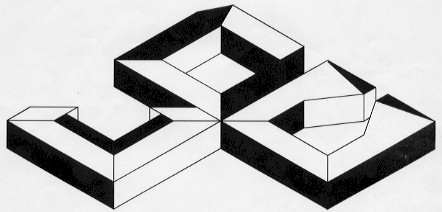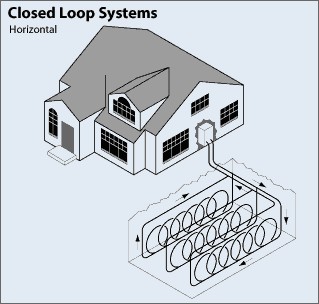

The Heating Cycle
In the heating cycle, the ground water, the antifreeze mixture, or refrigerant (which has circulated through the underground piping system and picked up heat from the soil), is brought back to the heat pump unit inside the house. It then passes through the refrigerant-filled primary heat exchanger for ground water or antifreeze mixture systems. In DX systems the refrigerant enters the compressor directly, with no intermediate heat exchanger.
The heat is transferred to the refrigerant, which boils to become a low-temperature vapour. In a closed-loop system, the anti-freeze mixture or refrigerant is pumped back out to the underground piping system to be heated again.
The reversing valve sends the refrigerant vapour to the compressor. The vapour is then compressed which reduces its volume, causing it to heat up.
Finally, the reversing valve sends the now-hot gas to the condenser coil, where it gives up its heat. Air is blown across the coil, heated, and then forced through the ducting system to heat the home. Having given up its heat, the refrigerant passes through the expansion device, where its temperature and pressure are dropped further before it returns to the first heat exchanger, or to the ground in a DX system, to begin the cycle again.
Domestic Hot Water
In some EESs, a heat exchanger, sometimes called a "desuperheater", takes heat from the hot refrigerant after it leaves the compressor. Water from the home's water heater is pumped through a coil ahead of the condenser coil, in order that some of the heat that would have been dissipated at the condenser is used to heat water. Excess heat is always available in the cooling mode, and is also available in the heating mode during mild weather when the heat pump is above the balance point and not working to full capacity. Other EESs heat domestic hot water (DHW) on demand: the whole machine switches to heating DHW when it is required.
Hot water heating is easy with EESs because the compressor is located inside. Because EESs have relatively constant heating capacity, they generally have many more hours of surplus heating capacity than required for space heating.
Cooling Cycle
The cooling cycle is basically the reverse of the heating cycle. The direction of the refrigerant flow is changed by the reversing valve. The refrigerant picks up heat from the house air and transfers it directly in DX systems or to the ground water or antifreeze mixture. The heat is then pumped outside, into a water body or return well (in the case of an open system), or into the underground piping (in the case of a closed-loop system). Once again, some of this excess heat can be used to preheat domestic hot water.
Unlike air-source heat pumps, EESs do not require a defrost cycle. Temperatures underground are much more stable than air temperatures, and the heat pump unit itself is located inside; therefore, the same problems with frost do not arise.